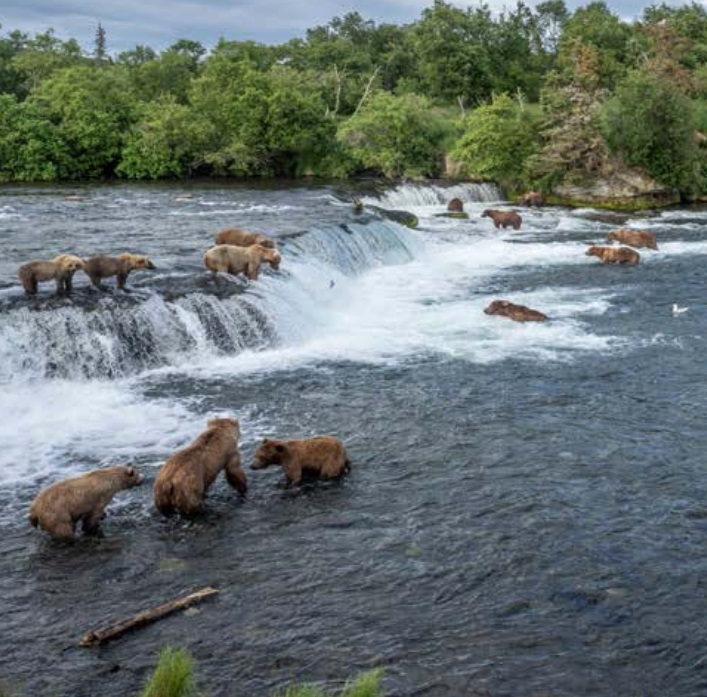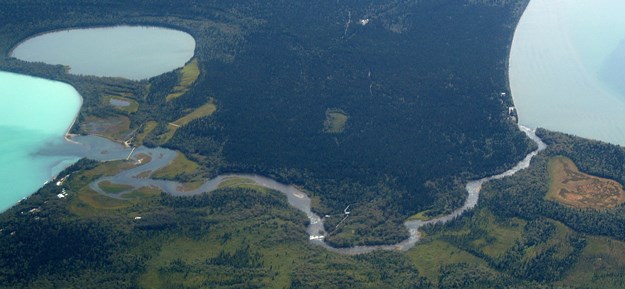Watch a bear cam above or visit Explore.org for all 8 bear cams.
Bear cam livestream begins again
Returning for a 12th season, the world-famous bear cam livestream at Katmai National Park in Alaska begins on June 20, 2024. The bear cams go live at 8 a.m. Alaska Daylight Time, or 11 a.m. CDT. Explore.org established the bear cams in 2012. The cams are situated along the Brooks River and at Brook Falls, where brown bears await salmon swimming upstream. Eight cameras will capture the action this year as bears compete for their supper. But you can also see other wildlife on the livestream, from eagles to gulls to the occasional wolf.
Brown bears come to Brooks Falls starting in late June because that’s when the salmon start migrating. By late summer, the salmon spawn and begin to die. So, in September and October, bear activity moves to the lower Brooks River. There, the bears search for dead and dying salmon near the mouth of the river. The most active months on the bear cams are July and September. Also, bears are diurnal, meaning they’re most active during the day. A bear at Brooks Falls can catch and eat more than 30 salmon a day.
Don’t forget, in the fall, to follow along with Fat Bear Week. That’s when the park shares before-and-after pictures, showing how much the bears have plumped up over a summer of engorging themselves. The public gets to vote on which bear they think did the best job of preparing for winter.

Brown bears on the bear cam
Alaska’s brown bears are those that live near the coast and eat salmon. Sometimes, people confuse them with grizzly bears. Grizzly bears in Alaska live farther inland, however. All grizzly bears are brown bears. However, not all brown bears are grizzly bears. The brown bears of Alaska are larger than the inland grizzlies.

Brooks Falls in Katmai
Brooks Falls has long been a popular spot to view brown bears in Alaska. The National Park Service hosts visitors at Brooks Camp on the Brooks River, where they’ve built boardwalks and viewing platforms for easier access to bear-gazing. There are north and south platforms near the camp at the mouth of the river and Naknek Lake, plus platforms at the falls itself and one downstream in the riffles, where less competitive bears come for meals. The National Park Service estimates there are about 2,200 bears in the park, with more bears than people living on the Alaskan Peninsula.

Valley of Ten Thousand Smokes
But Katmai is more than just bear territory. The U.S. government first set aside the land of Katmai in 1918 to protect the area around Novarupta volcano. In 1912, Novarupta exploded in the largest volcano eruption of the 20th century. For 60 hours, starting on June 6, the volcano spewed magma and ash, eventually releasing more than 30 times the output of the 1980 eruption of Mount St. Helens.
Scientists Robert F. Griggs visited the area four years later and was awed by the devastation, giving the area its nickname of Valley of Ten Thousand Smokes. Griggs wrote:
The sight that flashed into view … was one of the most amazing visions ever beheld by mortal eye. The whole valley as far as the eye could reach was full of hundreds, no thousands – literally tens of thousands – of smokes curling up from its fissured floor … It was as though all the steam engines in the world, assembled together, had popped their safety valves at once and were letting off surplus steam in concert.
Our feeling of admiration [for the Valley] soon gave way to one of stupefaction. We were overawed. For a while we could neither think nor act in a normal fashion.
NASA used this decimated landscape to train Apollo astronauts in 1965 and 1966.
Bottom line: The world-famous Katmai bear cam season begins on June 20, 2024. Find the livestream here and learn more about brown bears and Katmai National Park.
The post Katmai bear cam season begins now! Livestream here first appeared on EarthSky.
from EarthSky https://ift.tt/Hfq7QIM
Watch a bear cam above or visit Explore.org for all 8 bear cams.
Bear cam livestream begins again
Returning for a 12th season, the world-famous bear cam livestream at Katmai National Park in Alaska begins on June 20, 2024. The bear cams go live at 8 a.m. Alaska Daylight Time, or 11 a.m. CDT. Explore.org established the bear cams in 2012. The cams are situated along the Brooks River and at Brook Falls, where brown bears await salmon swimming upstream. Eight cameras will capture the action this year as bears compete for their supper. But you can also see other wildlife on the livestream, from eagles to gulls to the occasional wolf.
Brown bears come to Brooks Falls starting in late June because that’s when the salmon start migrating. By late summer, the salmon spawn and begin to die. So, in September and October, bear activity moves to the lower Brooks River. There, the bears search for dead and dying salmon near the mouth of the river. The most active months on the bear cams are July and September. Also, bears are diurnal, meaning they’re most active during the day. A bear at Brooks Falls can catch and eat more than 30 salmon a day.
Don’t forget, in the fall, to follow along with Fat Bear Week. That’s when the park shares before-and-after pictures, showing how much the bears have plumped up over a summer of engorging themselves. The public gets to vote on which bear they think did the best job of preparing for winter.

Brown bears on the bear cam
Alaska’s brown bears are those that live near the coast and eat salmon. Sometimes, people confuse them with grizzly bears. Grizzly bears in Alaska live farther inland, however. All grizzly bears are brown bears. However, not all brown bears are grizzly bears. The brown bears of Alaska are larger than the inland grizzlies.

Brooks Falls in Katmai
Brooks Falls has long been a popular spot to view brown bears in Alaska. The National Park Service hosts visitors at Brooks Camp on the Brooks River, where they’ve built boardwalks and viewing platforms for easier access to bear-gazing. There are north and south platforms near the camp at the mouth of the river and Naknek Lake, plus platforms at the falls itself and one downstream in the riffles, where less competitive bears come for meals. The National Park Service estimates there are about 2,200 bears in the park, with more bears than people living on the Alaskan Peninsula.

Valley of Ten Thousand Smokes
But Katmai is more than just bear territory. The U.S. government first set aside the land of Katmai in 1918 to protect the area around Novarupta volcano. In 1912, Novarupta exploded in the largest volcano eruption of the 20th century. For 60 hours, starting on June 6, the volcano spewed magma and ash, eventually releasing more than 30 times the output of the 1980 eruption of Mount St. Helens.
Scientists Robert F. Griggs visited the area four years later and was awed by the devastation, giving the area its nickname of Valley of Ten Thousand Smokes. Griggs wrote:
The sight that flashed into view … was one of the most amazing visions ever beheld by mortal eye. The whole valley as far as the eye could reach was full of hundreds, no thousands – literally tens of thousands – of smokes curling up from its fissured floor … It was as though all the steam engines in the world, assembled together, had popped their safety valves at once and were letting off surplus steam in concert.
Our feeling of admiration [for the Valley] soon gave way to one of stupefaction. We were overawed. For a while we could neither think nor act in a normal fashion.
NASA used this decimated landscape to train Apollo astronauts in 1965 and 1966.
Bottom line: The world-famous Katmai bear cam season begins on June 20, 2024. Find the livestream here and learn more about brown bears and Katmai National Park.
The post Katmai bear cam season begins now! Livestream here first appeared on EarthSky.
from EarthSky https://ift.tt/Hfq7QIM

Aucun commentaire:
Enregistrer un commentaire